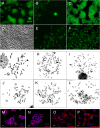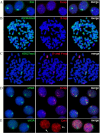Alternative dominance of the parental genomes in hybrid cells generated through the fusion of mouse embryonic stem cells with fibroblasts
- PMID: 29273752
- PMCID: PMC5741742
- DOI: 10.1038/s41598-017-18352-4
Alternative dominance of the parental genomes in hybrid cells generated through the fusion of mouse embryonic stem cells with fibroblasts
Abstract
For the first time, two types of hybrid cells with embryonic stem (ES) cell-like and fibroblast-like phenotypes were produced through the fusion of mouse ES cells with fibroblasts. Transcriptome analysis of 2,848 genes differentially expressed in the parental cells demonstrated that 34-43% of these genes are expressed in hybrid cells, consistent with their phenotypes; 25-29% of these genes display intermediate levels of expression, and 12-16% of these genes maintained expression at the parental cell level, inconsistent with the phenotype of the hybrid cell. Approximately 20% of the analyzed genes displayed unexpected expression patterns that differ from both parents. An unusual phenomenon was observed, namely, the illegitimate activation of Xist expression and the inactivation of one of two X-chromosomes in the near-tetraploid fibroblast-like hybrid cells, whereas both Xs were active before and after in vitro differentiation of the ES cell-like hybrid cells. These results and previous data obtained on heterokaryons suggest that the appearance of hybrid cells with a fibroblast-like phenotype reflects the reprogramming, rather than the induced differentiation, of the ES cell genome under the influence of a somatic partner.
Conflict of interest statement
The authors declare that they have no competing interests.
Figures





Similar articles
-
Dominance of parental genomes in embryonic stem cell/fibroblast hybrid cells depends on the ploidy of the somatic partner.Cell Tissue Res. 2010 Jun;340(3):437-50. doi: 10.1007/s00441-010-0987-3. Epub 2010 May 30. Cell Tissue Res. 2010. PMID: 20512590
-
Bidirectional reprogramming of mouse embryonic stem cell/fibroblast hybrid cells is initiated at the heterokaryon stage.Cell Tissue Res. 2010 Dec;342(3):377-89. doi: 10.1007/s00441-010-1085-2. Epub 2010 Nov 20. Cell Tissue Res. 2010. PMID: 21103994
-
Transcriptional changes in somatic cells recovered from embryonic stem-somatic heterokaryons.Stem Cells Dev. 2009 Nov;18(9):1361-8. doi: 10.1089/scd.2008.0361. Stem Cells Dev. 2009. PMID: 19222348
-
Embryonic hybrid cells: a powerful tool for studying pluripotency and reprogramming of the differentiated cell chromosomes.An Acad Bras Cienc. 2001 Dec;73(4):561-8. doi: 10.1590/s0001-37652001000400009. An Acad Bras Cienc. 2001. PMID: 11743603 Review.
-
Reprogramming mediated by cell fusion technology.Int Rev Cell Mol Biol. 2011;291:155-90. doi: 10.1016/B978-0-12-386035-4.00005-7. Int Rev Cell Mol Biol. 2011. PMID: 22017976 Review.
Cited by
-
Prevention of Bleomycin-Induced Pulmonary Inflammation and Fibrosis in Mice by Bilobalide.Evid Based Complement Alternat Med. 2023 Jan 24;2023:1973163. doi: 10.1155/2023/1973163. eCollection 2023. Evid Based Complement Alternat Med. 2023. PMID: 36733844 Free PMC article.
-
Immortalized murine fibroblast cell lines are refractory to reprogramming to pluripotent state.Oncotarget. 2018 Oct 16;9(81):35241-35250. doi: 10.18632/oncotarget.26235. eCollection 2018 Oct 16. Oncotarget. 2018. PMID: 30443291 Free PMC article.
References
Publication types
MeSH terms
LinkOut - more resources
Full Text Sources
Other Literature Sources

